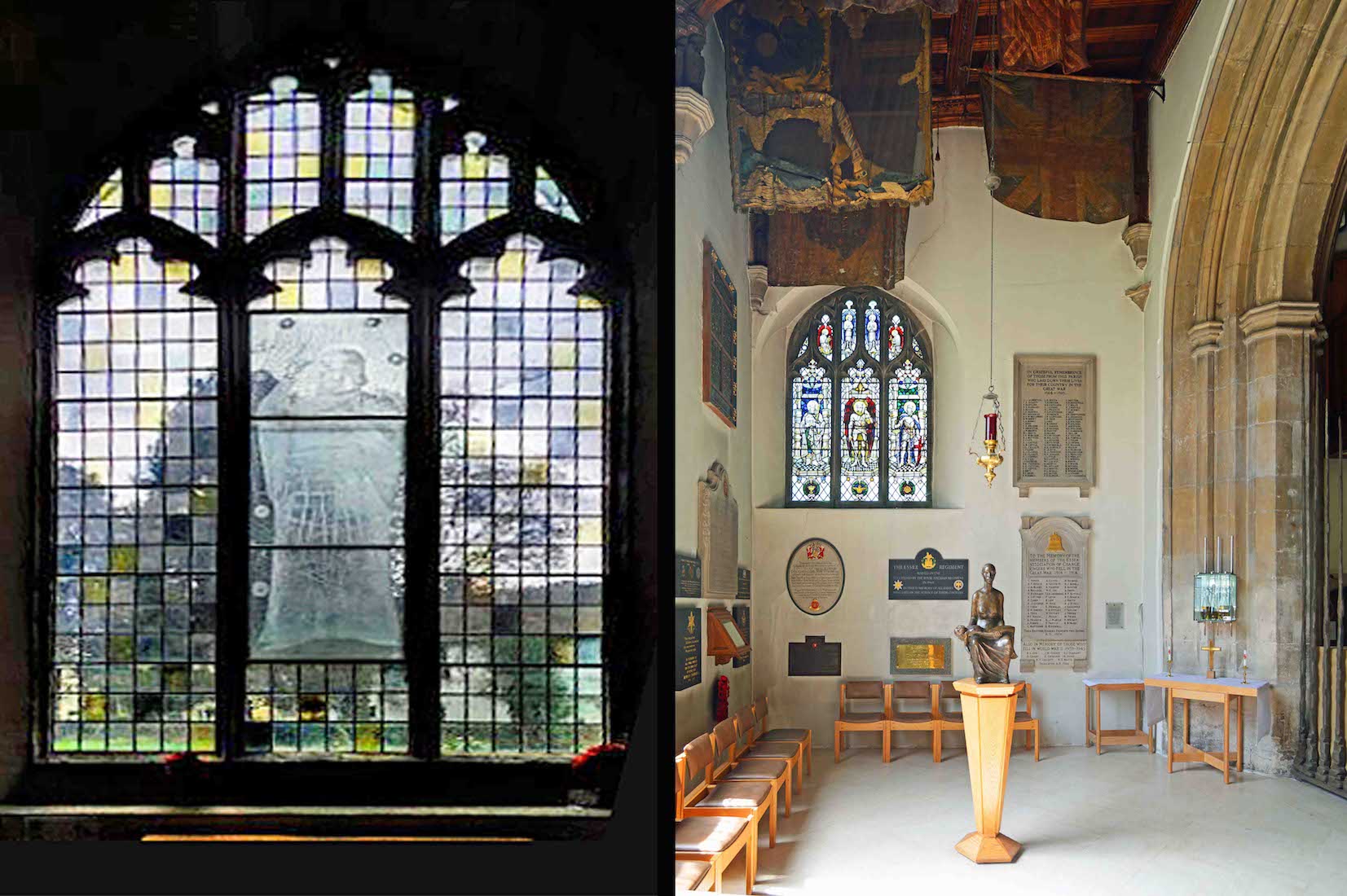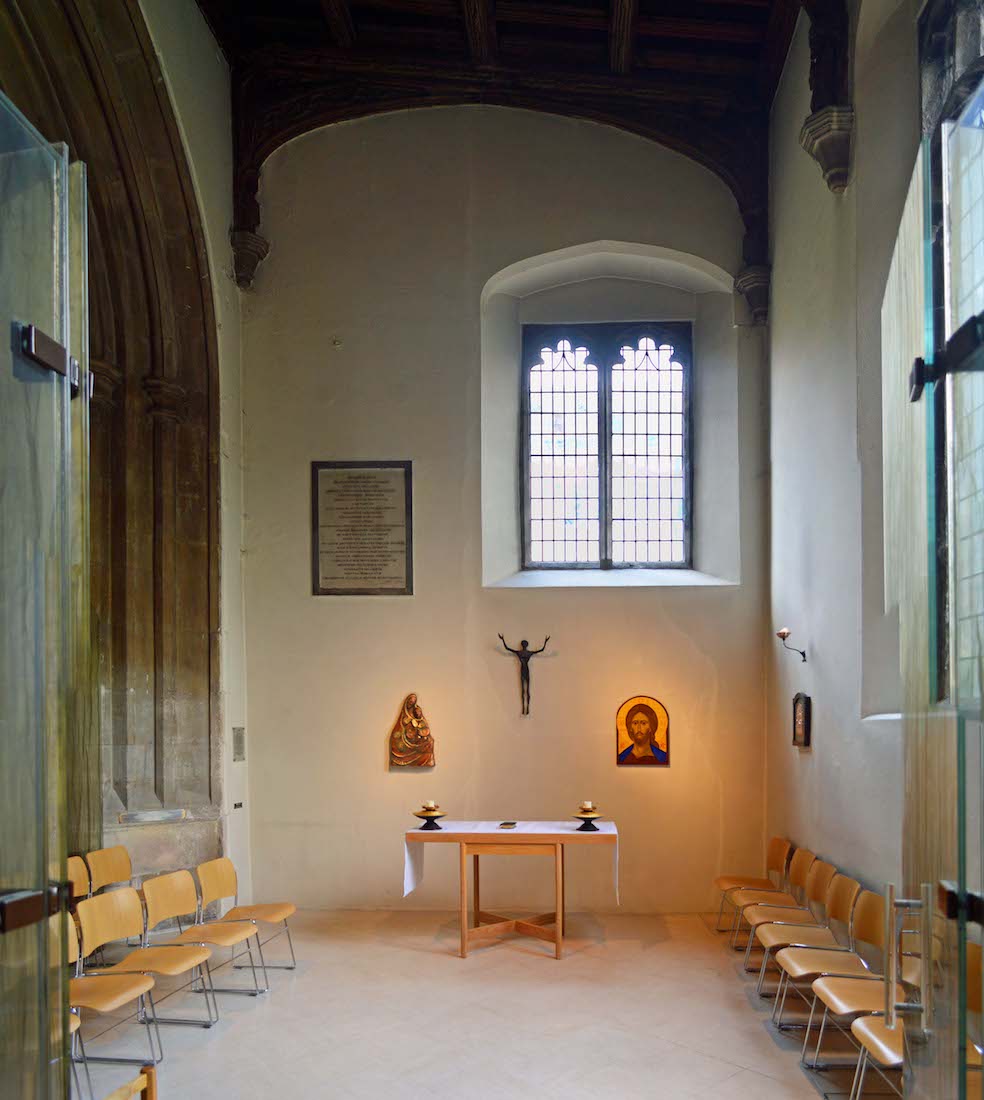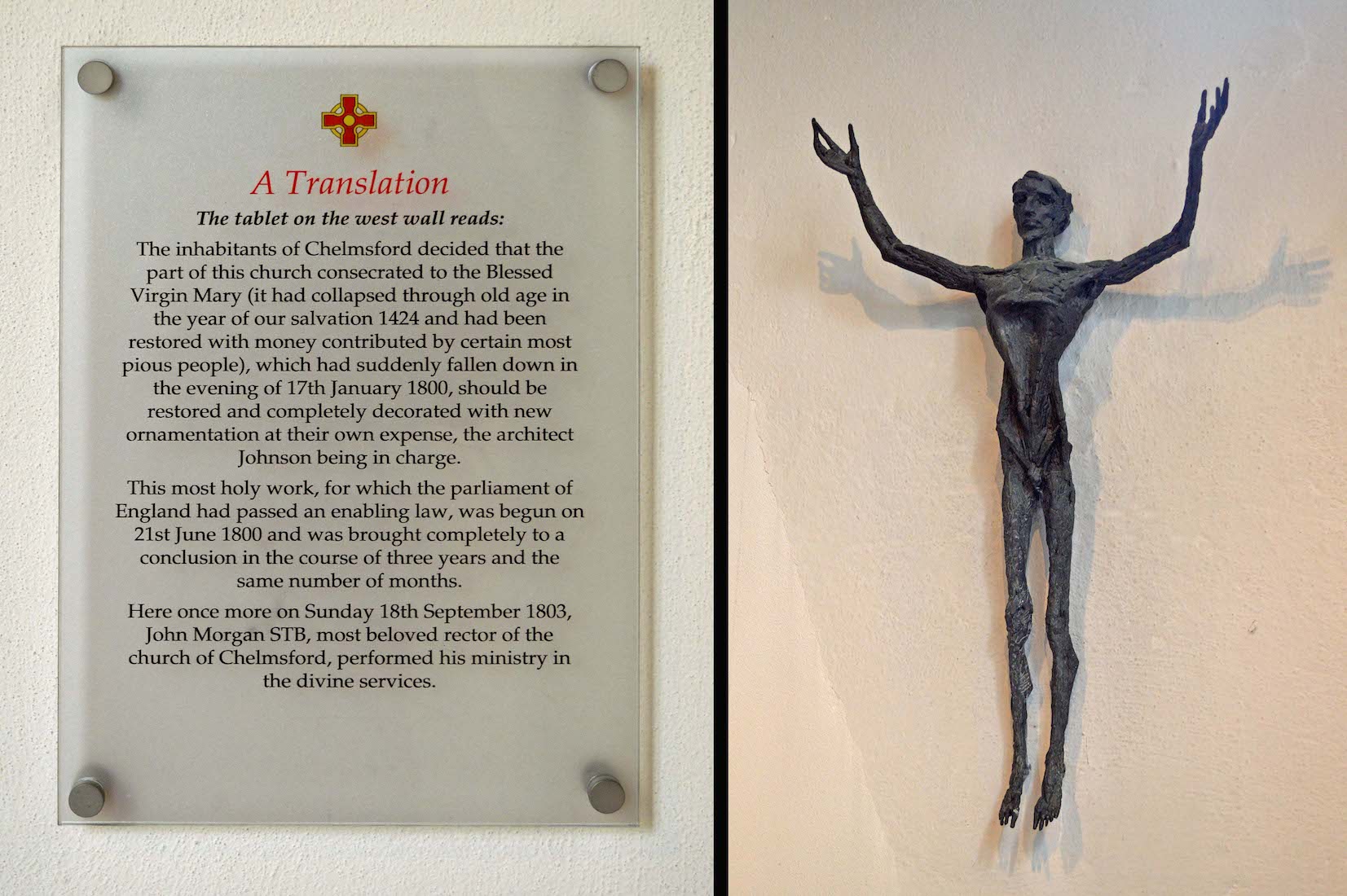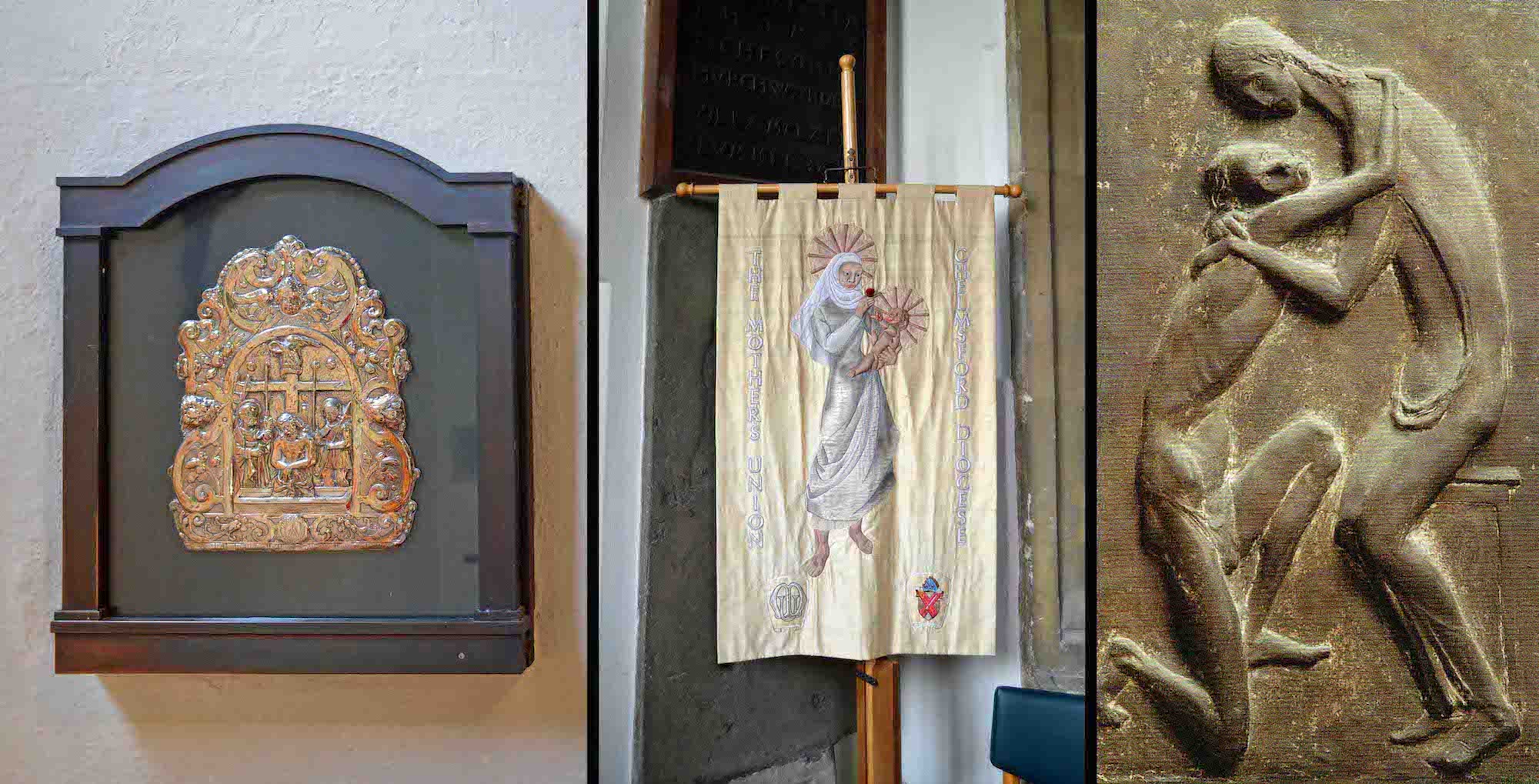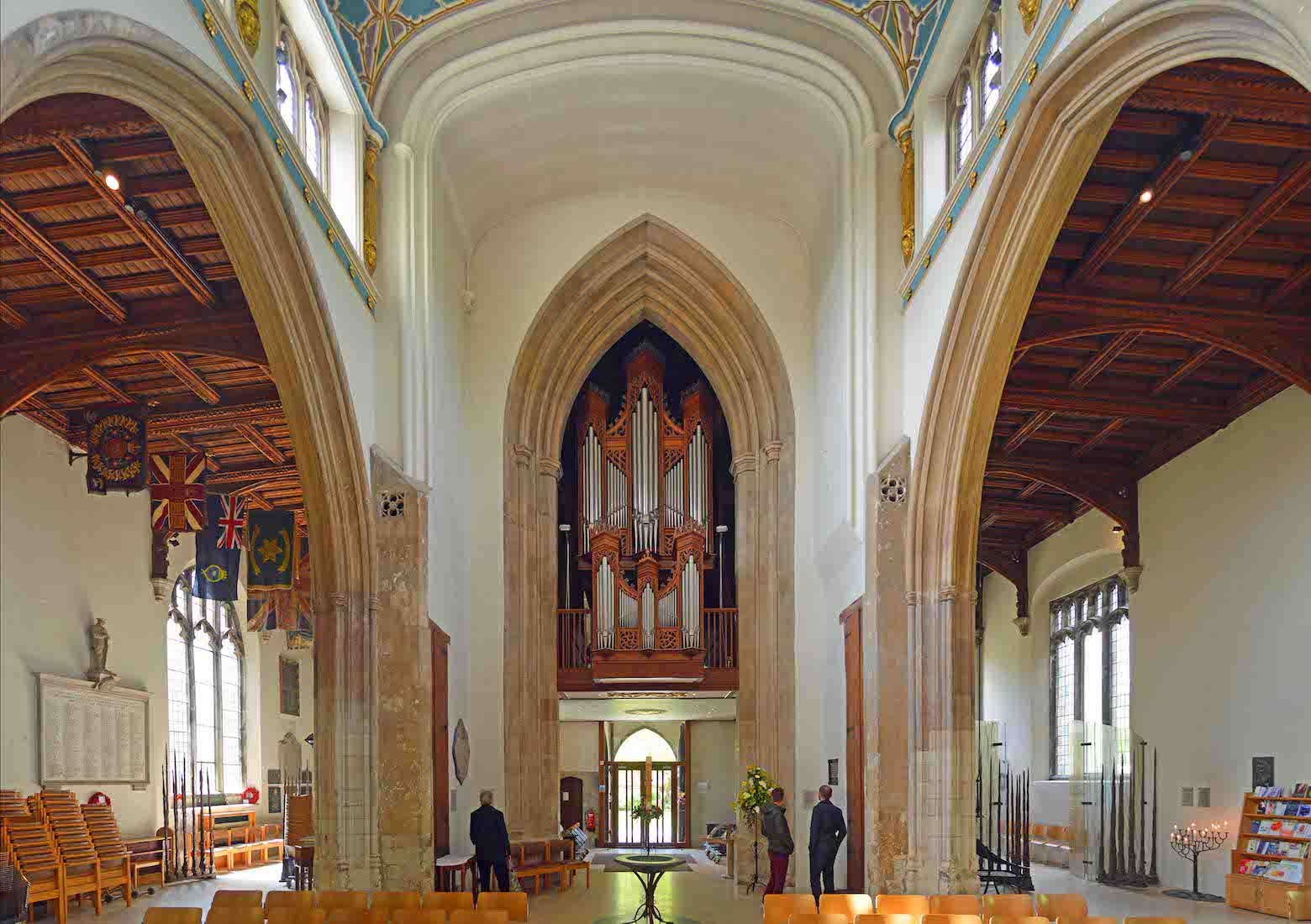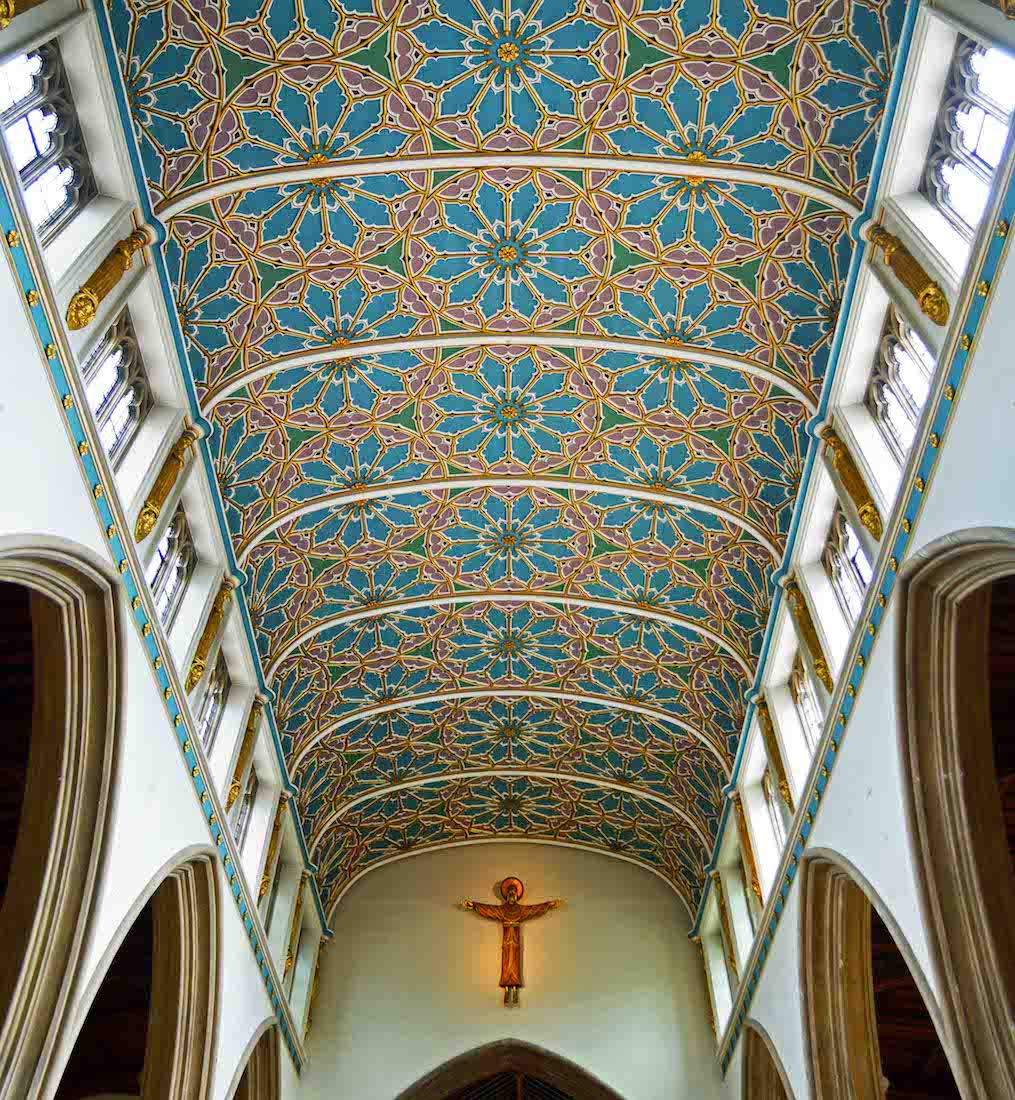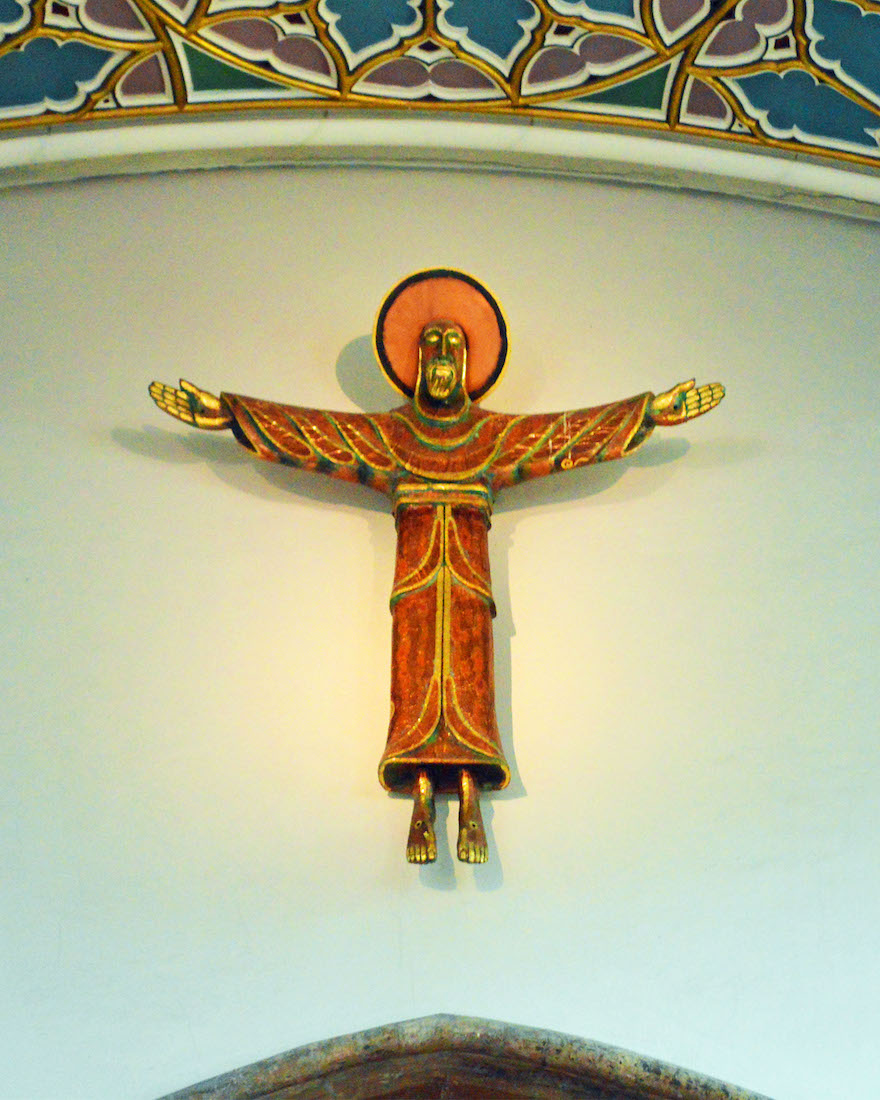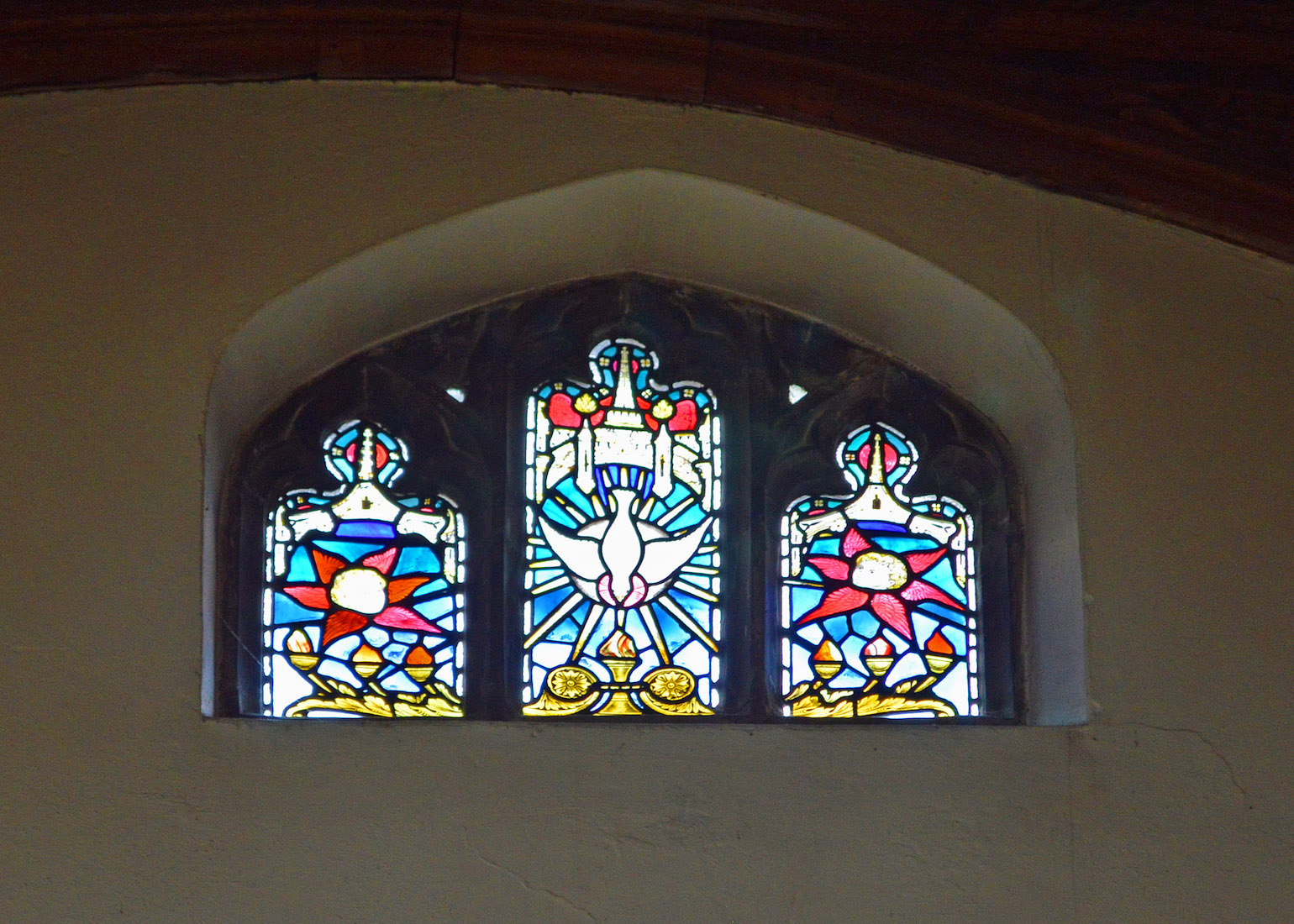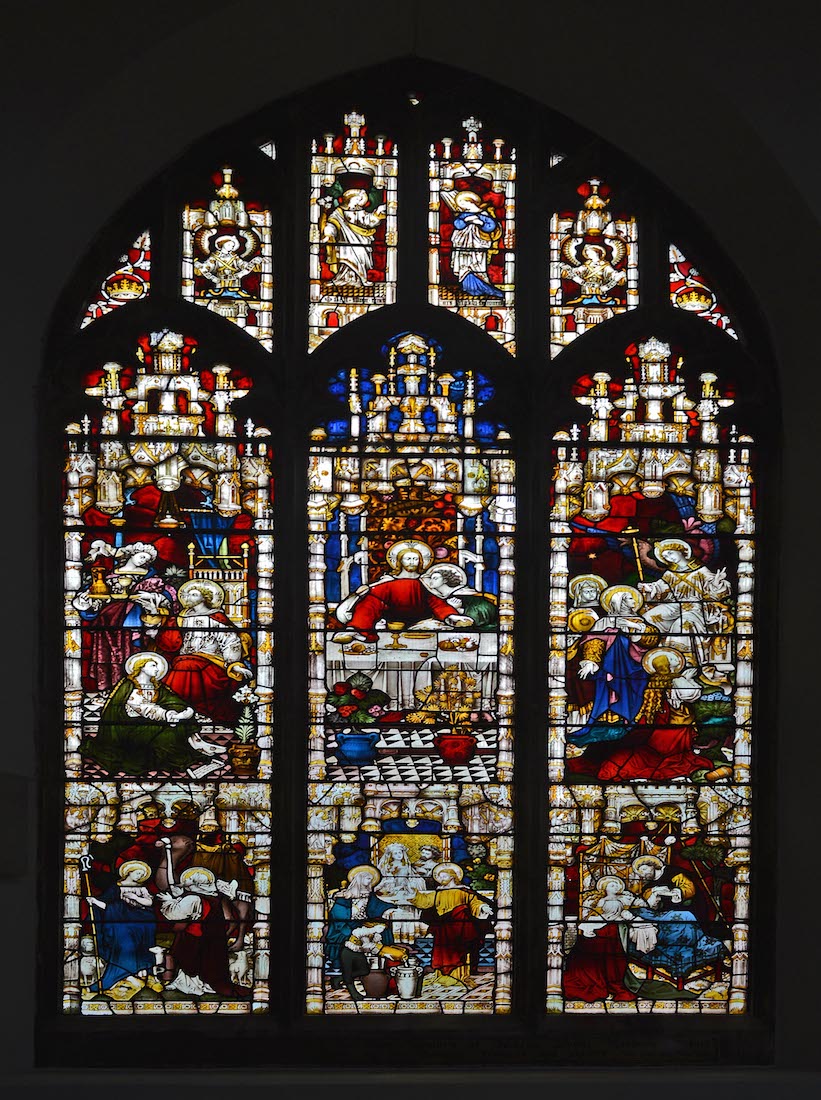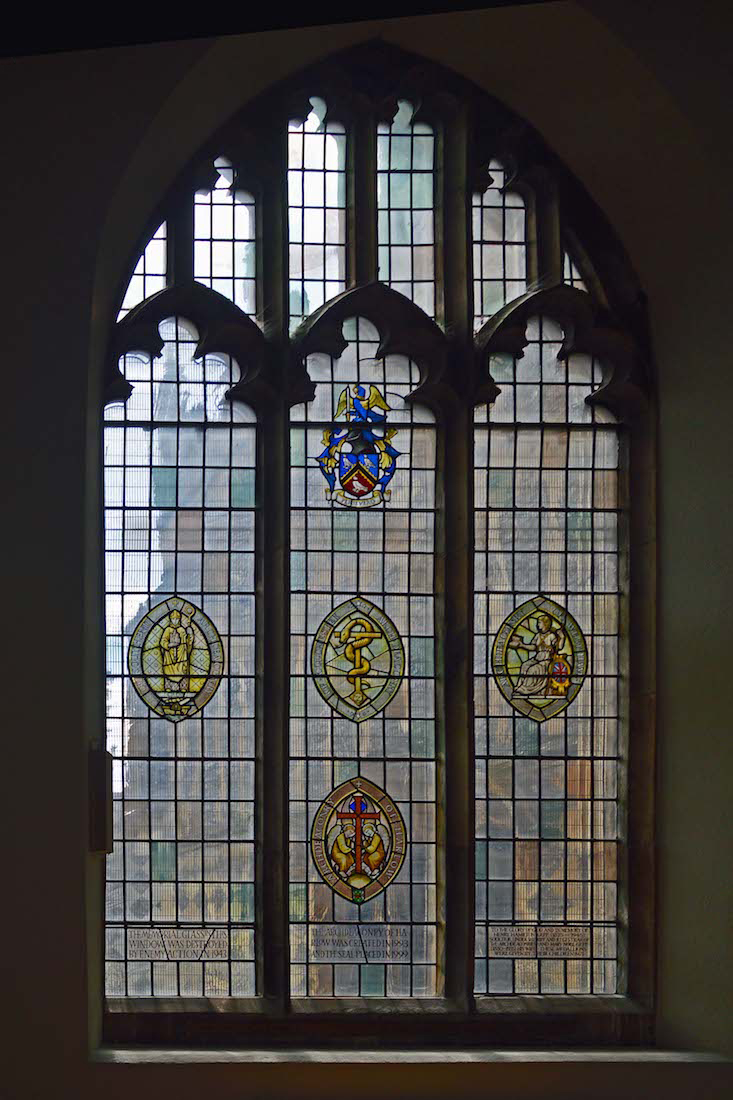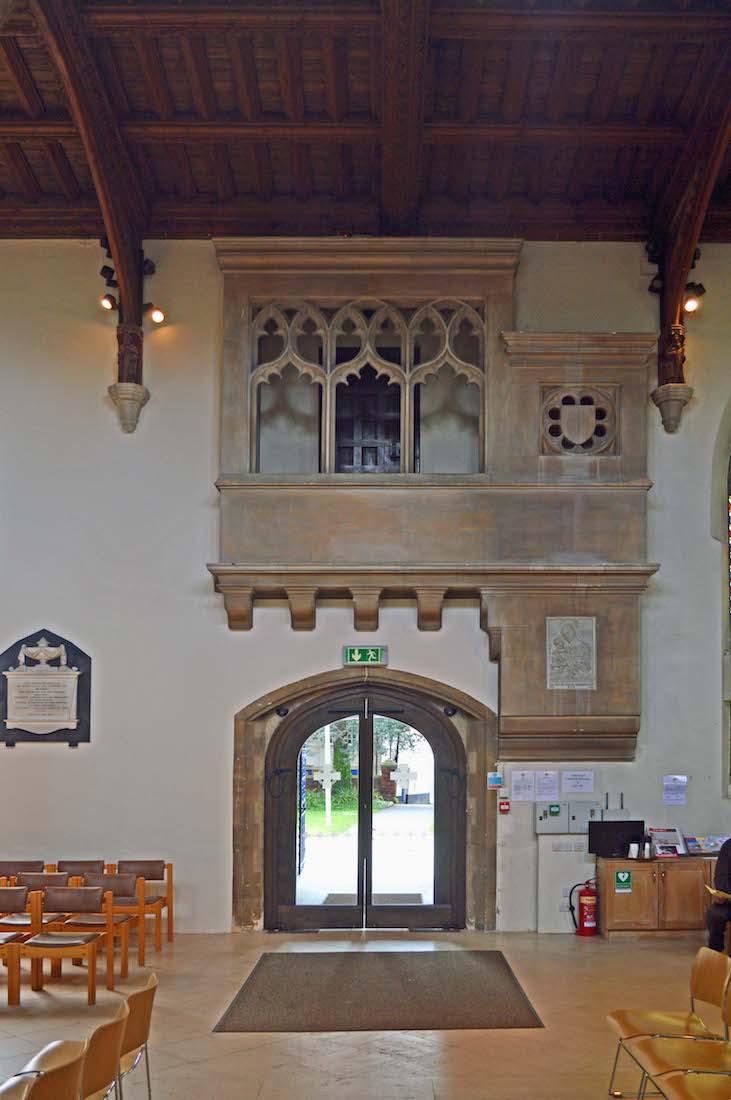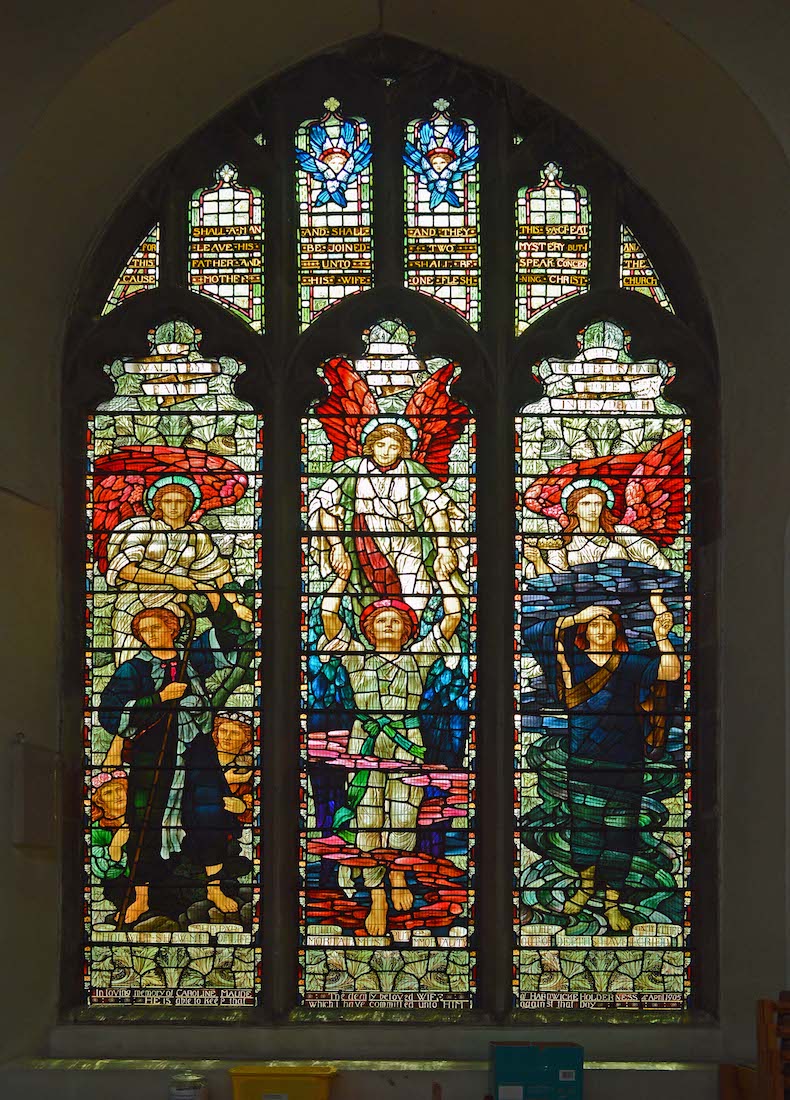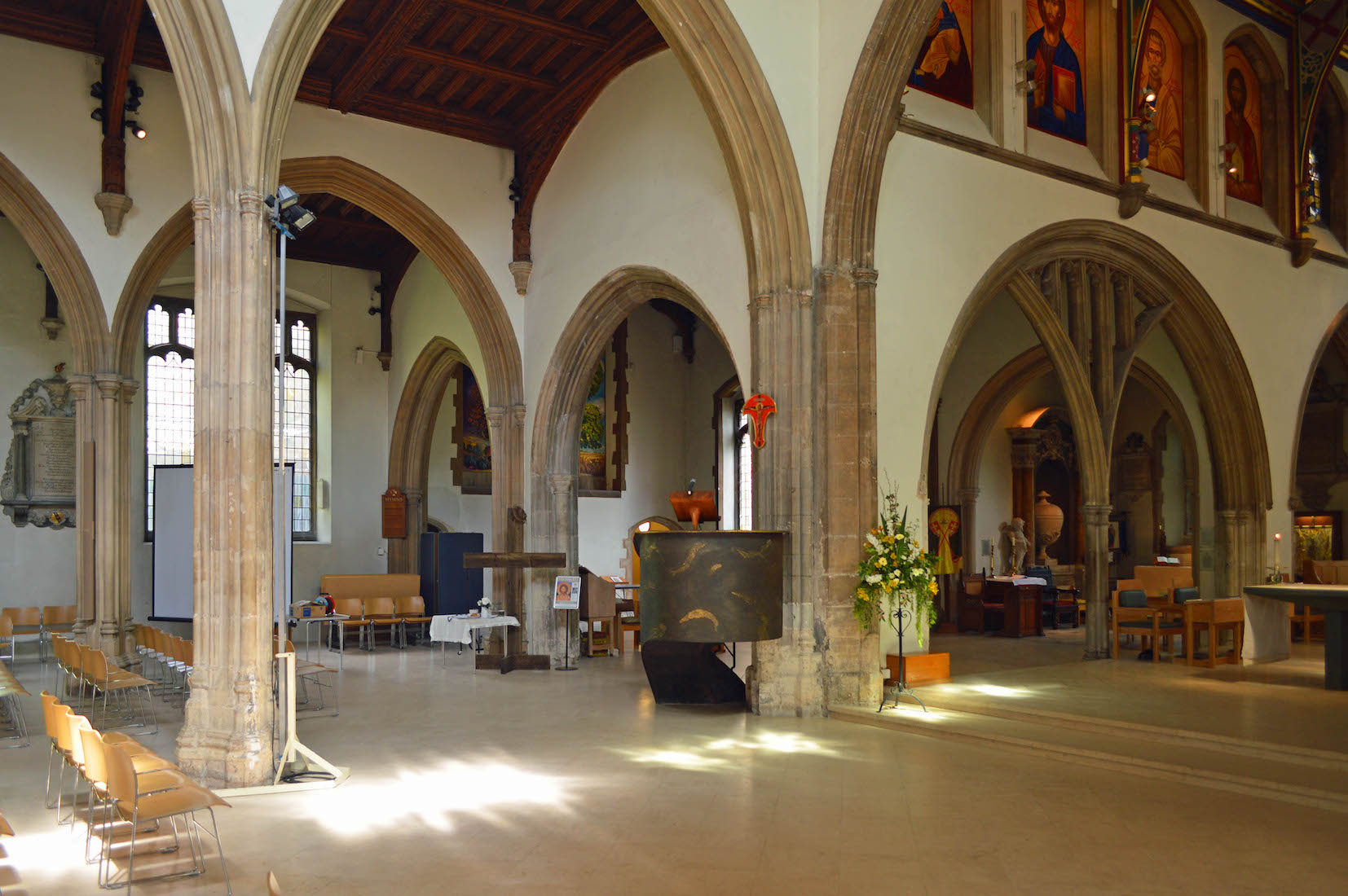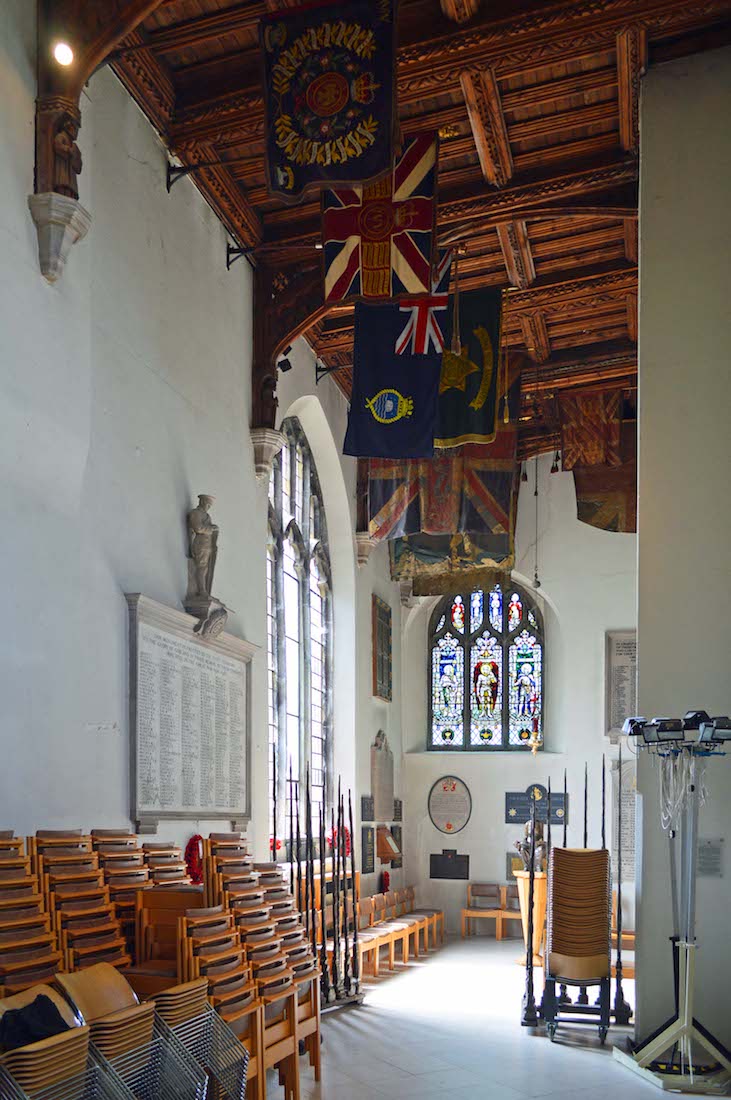
St Peter’s Chapel is located in the Southwest corner of the Cathedral, and is seen here at the end of the South nave aisle. There appears to be an Honour Roll on the wall at left, and above us hang the colours of various regiments. It is a long established custom that when a regiment gets disbanded, its colours are hung in the local cathedral. PLAN
22. HONOURS ROLL AND ‘RIFLES’
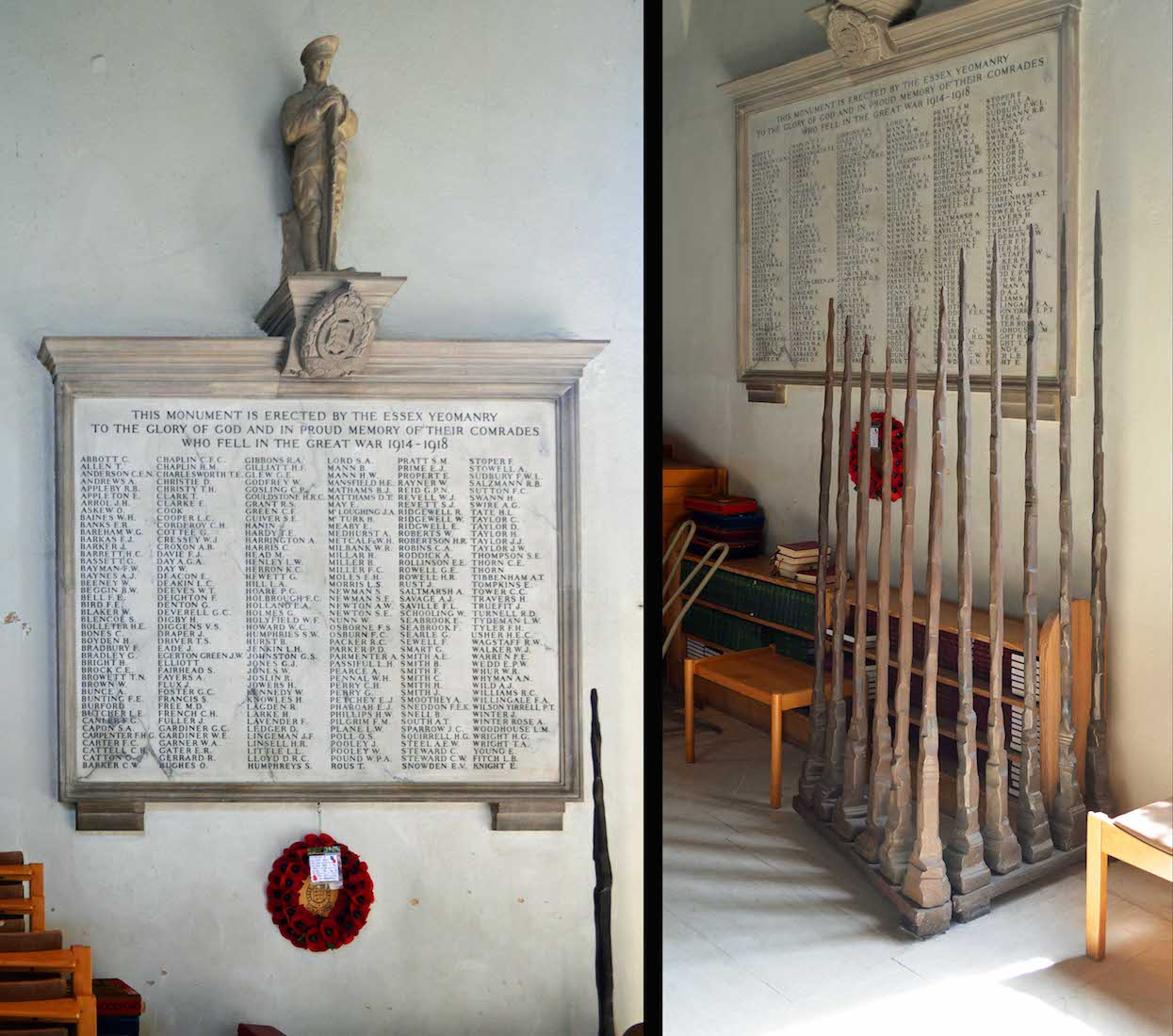
The Honours Roll contains the names of local men who gave their lives in the Great War of 1914–18. On either side of the chapel entrance are wooden stands which look to be racks of imitation rifles.
23. ST PETER’S CHAPEL
St Peter’s Chapel is a monument to those who suffer in this world. In the Southern window at left, the figure of St Peter has been incised in a sheet of plain glass by the artist John Hutton. It dates from 1969. The walls of the chapel are lined with various memorial plaques. The bronze sculpture, ‘The Bombed Child’, is by Georg Ehrlich who was displaced from his native Austria following the Nazi invasion in 1938. There is a West window, and a simple altar at right.
24. CHAPEL WINDOW AND ALTAR
This three light window commemorates those of the parish who fell in WWI. The window is the work of Archibald K Nicholson in 1922. It depicts three saints: St Nicholas, the patron saint of sailors – his symbols are a sailing ship and cockle shell; • St Michael, the patron saint of airmen – he has wings; • St George, the patron saint of soldiers, bears a sword. Above the simple altar is a glass and chrome tabernacle by Bernard Merry (2009). It holds three flasks containing the Holy Oils.
25. ST CEDD’S CHAPEL
This chapel is in the Northwest corner of the Cathedral. Cedd (620 – 664) was an Anglo-Saxon monk and bishop from the Kingdom of Northumbria. He was an evangelist of the Middle Angles and East Saxons in England and a significant participant in the Synod of Whitby. The Chapel is used for daily worship and prayer. It shows all signs of being a Lady Chapel.
26. TRANSLATION AND CHRISTUS
The printed sheet is a translation of a proclamation about the restoration of this part of the old Church dedicated to the Virgin Mary, which was restored after having suddenly fallen down in 1800. The bronze Christus is by local sculptor Thomas Huxley-Jones and dates from 1971.
27. MOTHER AND CHILD, AND CHRIST ICON
The ‘Mother and Child’ bas-relief is by Peter Eugene Ball and dates from 2000. It is made of oak covered in beaten copper and decorated with gilt. The icon of Christ was written at the same time as the icons in the chancel – 2010.
28. CHAPEL ITEMS
On the North wall of the chapel is an aumbry, holding the reserved Elements of the Eucharist for use with ill or shut in parishioners. The Mothers’ Union banner at the rear of the chapel depicts Mary holding the Infant Jesus. The relief of ‘Christ the Healer’ by Georg Ehrlich is on the North wall, just outside the St Cedd Chapel screen. [Cathedral photo]
29. WEST NAVE
Leaving St Cedd’s Chapel we return to the nave, standing just in front of the font. Looking back we have this panoramic view of the West of the nave with the organ at the centre and a chapel on either side. Impressive!
30. NAVE
. 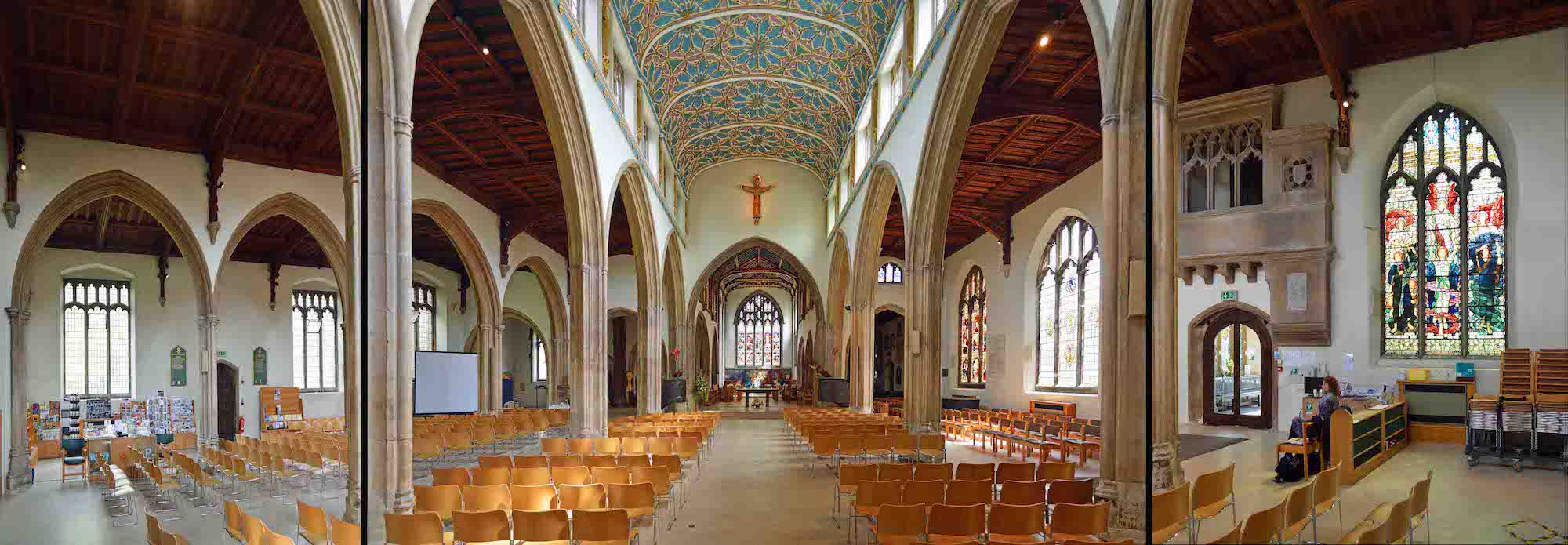
Turning around we now view the nave looking towards the sanctuary. Towards the North we see plain windows and minimal decoration. To the South, more interesting stained glass windows, and the door through to the South porch. And directly in front, a wonderful ceiling and Christ figure, with gothic arches directing us to the chancel and sanctuary. Notice the high window over the far right arch.
31. NAVE CEILING
The 15th century nave was rebuilt by John Johnson after the disastrous collapse in 1800, with the arcading in its original style, and with galleries which were later removed. The nave ceiling and clerestory were the result of this restoration. The ceiling was coloured and gilded in 1961. Tall straight figures separate the clerestory windows, and a colour variation indicates the stained glass of the far two clerestory windows on either side.
32. CHRIST IN GLORY
Many cathedrals have a rood Cross in this position above the chancel arch. This Cathedral has a sculpture of ‘Christ in Glory’ by Peter Eugene Ball. It is a strong and welcoming image made of oak covered with beaten copper and decorated with gilt. Peter Ball has made several contributions to Chelmsford Cathedral, including the previously seen ‘Mother and Child’ in St Cedd’s Chapel.
33. HOLY SPIRIT WINDOW
To the East, the South aisle passes under an arch containing this window. Designed by Gibson and Company in 1900, it is a memorial window for Mr Rogers, ex-headmaster of KEGS (King Edward VI Grammar School), presented by his wife. The window shows the white dove of the Holy Spirit descending, and tongues of fire.
34. NAVE CLERESTORY WINDOWS
High above in the nave are two rows of clerestory windows. Most of them have clear glass, but the two closest to the chancel are more interesting. Parishioners in 1922 gave these windows to mark 25 years of Canon Lake’s ministry. The windows all have a praise theme. The North windows (left) show the world, stars, clouds and lightning around angels making music (Psalm 134). The South windows (right) show suns, stars and the moon around angels reading from a lectern and spreading incense (Psalm 98).
35. NORTH NAVE WALL
We now move across to the North nave wall. On either side of the North door are two lists dating from 1914 when the Church became a Cathedral. The first board lists the bishops of the diocese, the second the rectors, provosts and deans. Further East on this wall there is a plaque commemorating Royal attendance at the Chelmsford Borough centenary celebrations. Finally there is a memorial to Robert Bownd who lived in the late 17th century, and his son Eleazar.
36. BIBLICAL SCENES WINDOW
At the Eastern end of the nave South aisle is a window depicting Biblical scenes. Scenes include Martha and Mary, the Last Supper, Mary Magdalene at the empty tomb, Jacob and Rachel at the well, the marriage in Cana, and the healing of a child. The window was made by Clayton and Bell, and was donated in 1873 in memory of Ismena Tindal Hanbury.
37. ARCHDEACONRY WINDOW
This window is just East of the South porch. It replaces a window destroyed in WWII. It depicts the seals of the (then) three archdeaconries of Essex: Southend, Colchester, West Ham. At top is the coat of arms of the Gepp family who donated the window in memory of Henry Hamilton Gepp. Below is a fourth archdeaconry seal added in 1999 dedicated to Harlow.
38. SOUTH PORCH DOOR
As we move along the South aisle, we next come to the South porch door. Above is a balcony fronting the (now) upstairs library. At right is a plaque acknowledging the donor.
39. HOLDERNESS WINDOW
This window is well known as being designed by the pre-Raphaelite artist Henry Holiday, and made by the firm Lowndes and Dury. It shows the passage of the human soul along the steep path of life, through the river of death, until it reaches Paradise. It was commissioned by Lieutenant Holderness in memory of his wife Caroline who died in 1905.
40. NORTH EAST NAVE
At the East end of the North aisle we find an interesting looking pulpit, and a rough hewn cross. Beyond is an intriguing painting in the North transept.


